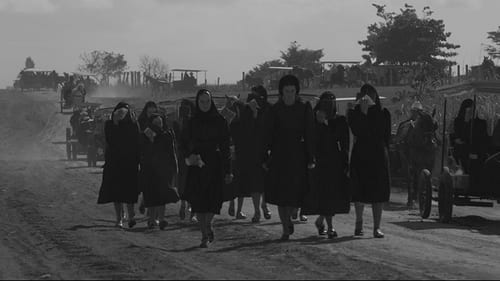Hermógenes Cayo (Imaginero) (1969)
장르 : 다큐멘터리
상영시간 : 1시간 8분
연출 : Jorge Prelorán
시놉시스
IMAGINERO is an ethnobiography of Hermogenes Cayo, a self-taught woodcarver and painter who lives on the high Andean plateau of Argentina. The film portrays Hermogenes, his wife Aurelia Kilpe, and their children in their Andean lifestyle, as well as Hermogenes' passion for painting, carving, building, and his devotion to the Virgin Mary. Devout, austere and dedicated to craftsmanship, he can make anything from religious figures carved from cactus wood to a working harmonium. Inspired by a trip to Buenos Aires to advocate for land rights, Hermogenes has labored to replicate the style of the capital's grand cathedral and shrine to the Virgin with resourcefulness and skill.

On the island of Tanna, a part of Vanuatu, an archipelago in Melanesia, strange rites are enacted and time passes slowly while the inhabitants await the return of the mysterious John.

A portrait of Santos Port, its geography, workers and the life that surrounds it, including the poor, prostitutes and the night life inhabitants.

With a dual motion a cruise ship and a fishing boat pass one another on the Nile and butlers in turbans set up a wooden gangway. Thanks to a rope and pulley system cows climb skywards then disappear into the hold of the sailing vessel. On the bank, black-haired women rock back and forth, bursting out laughing and showing the first signs of going into a state of trance. Never-before filmed gestures and faces of the people of the Nile succeed one another, uprooted to an unknown, magical world. The Banks of the Nile is one of the first experiments of film in colour that uses the Kinemacolor process.

A documentary that invites us to discover the strange path led by the explorer-ethnographer Marquis de Wavrin who, in the 1920s and 1930s, made ethnographic films in several countries of Latin America.

At a 2005 Carnival night, something mysterious happens at Porto Formoso bay, leaving the fishing boats wrecked. Fishermen decide to build bigger boats, but at the small village harbor it is impossible to deck them. They demand the construction of a new harbor, but many inhabitants are opposed due to a Castle ruins that lay there. If to some residents ruins look worthless, for others they are the village soul and future, as a lot of tourists would like to visit them...While the landscape transforms, we follow the Director voice through the story of the last seven years of this community.

Between Africa and the catalonian Penedés stands the distance of a videocamera. A cut. What is what, where are we, where did the songs we sang while we worked go, where is the group, the colective, the community?

Amanar Tamasheq parts from the exciting adventure of the director on a trip with the Tuaregs rebels in the desert of Mali, to convert the camera into the most powerful weapon. The terrible history of this people, always under threat, is built through their own words in a text that, from their own statements reworked, overlaps in the form of subtitles to images. These, far in the highest degree of language that normally tells the violent, they gain political power and radical rarely seen.

A sensory record of the relationships of affinity and enmity with fire in the conservation of the Cerrado biome.
In the company of local residents hired to act as brigadiers and, more recently, as management agents, the short film explores the affections established with fire in the midst of combat pyrophobias and management pyrophilias.
In addition to documenting fire fighting and manipulation techniques, the cinematographic experiment points to a more than human visual anthropology, where environmental forces such as heat, vegetation and wind make up an alterity whose condition remains ambiguous.

Two first-time filmmakers stop their lives to find out why rhinos are being killed for their horns. Carving out six months for the project, the women quickly find themselves immersed in a world far larger and more dangerous than they had imagined, only emerging from their odyssey four years later.

Point Blank is an investigative documentary on police violence and corruption perpetrated in Rio de Janeiro in the past 20 years. It vividly portrays the most emblematic incidents that occurred during this period through the perspective of family members, witnesses, survivors, and other people who were directly involved in such cases. The film starts with the notorious Vigario Geral Massacre of 1993 and culminates with the executions ordered and carried out by law enforcement agents in 2012 and 2013. These brutal facts are presented based on witness reports that reconstruct the memory of the few who survived the slaughters.

Despite never having played the game before, a group of underprivileged teens emerge as a talented lacrosse team under the tutelage of Coach Bobby Selkin.

The very first documentary about Jane Elliott's educational experiment about discrimination, which was originally produced for ABC News, in which she conducts an unforgettable lesson with her third-grade class in Riceville, Iowa.

In Sutarkhali, a small village on the Bangladeshi coast, a family, having suffered from the endless floods and storms, tries to rebuild its life.

A documentary about the eponymous Puerto Rican boxer

Romania, 1986: Gregor and Vali want to get away. Both need each other, yet there is mutual distrust. One night Gregor finds his doubts confirmed. In the end only hope is left.

The "Field of Magic" is a docu-poem about people living for over two decades in the Buda forest, near the closed down Kariotiskes dump in Lithuania. After four years of work, this film captures the perspective of the dump dwellers. It tells the story about the dissolving community, its uniqueness, daily routine, specific way of life, every-day joys and sorrows.

Mariquilla is a beautiful gypsy who is in love with Lucas, a soldier of the garrison in the Alhambra, but her father wants to marry her with Don Cosme, a rich old clerk for the service of the mayor. Soon, the girl asks for help to the governor of Granada, a gentleman who has always had a great adoration for the girl.

A man with no illusions marries a young woman who is brimming with idealism. She attempts to remake her husband with her overflowing optimism, but the marriage is severely strained when her first pregnancy ends in miscarriage. They separate, and the woman has a number of affairs, but eventually she returns to her husband. They have a daughter, then settle down to a life that is a blend of the husband's worldliness and the wife's idealism.

Lunch Break features 42 workers as they take their midday break in a corridor stretching nearly the entire shipyard.

This documentary chronicles the life of expatriate writer Paul Bowles through archival footage, photos and interviews with the author, who talks about his writing, his friendships with artists such as Tennessee Williams and Aaron Copland and more. Shot in Tangier, Morocco (Bowles's longtime home), this revealing portrait sketches out Bowles's rebellious life story, including his love relationships with men and women, his drug use and his music. - Paul Bowles, Edouard Roditi, Allen Ginsberg

For generations, the Salamanca community of Mennonites has been living in the same modest and rigidly organized way. Modern-day scenes are accompanied by a voice-over narrating a man’s recollections of his youth. “As soon as I close my eyes,” he explains, “I go back to the past, to the moment when I made the choice that shaped my entire life.” Speaking in the Plautdietsch language, he talks calmly of the strong curiosity he felt as a young boy about the world beyond Salamanca and the Mennonite faith – a curiosity for which he paid dearly.

Hellion — "Shum bola", a film on the eponymous story of Gafur Gulyam about the adventures of a little boy, whose restless character makes him different people and life situations.

The third part of Euripides’ trilogy relates Orestes’ confrontation with the people of Argos after killing his mother Clytemnestra and her lover Aegisthus, and his struggle to defend himself and his heritage – with the support of his sister, Electra.

Documentary depicting what happened to the characters in the film Terra para Rose, made by the same director. Shows the life of some 1500 families of landless rural laborers who, for the first time in 1985, occupied an unproductive large landholding, the Annoni plantation in Rio Grande do Sul. After camping out for years in tents, facing down the police and negotiating with the government, the former landless laborers have managed to turn their dream into reality, and are now successful small farmers.

Inspired by the German folktale, Wilhelm, a file clerk, falls in love with a huntsman's daughter. In order to marry, Wilhelm must prove his worth as a hunter and gain her father's approval. Naive and desperate, he makes a deal with a devil named Pegleg.

In 1972, a Hollywood producer's swinging party takes a strange turn when an uninvited guest comes for more than sex and drugs.






